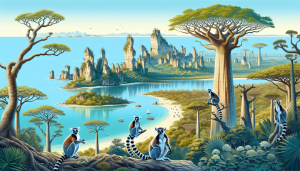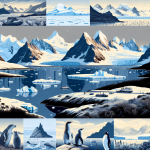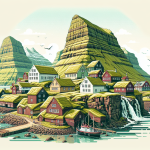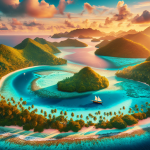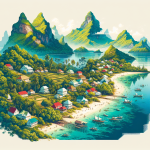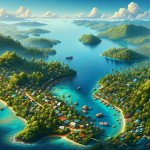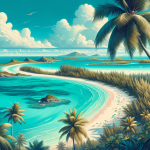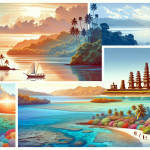Discover the Enigmatic Allure of Madagascar: A Traveler’s Paradise
Madagascar, the world’s fourth-largest island, is a destination that beckons travelers with its unique blend of biodiversity, culture, and adventure. Nestled off the southeastern coast of Africa, this enchanting island nation offers an unparalleled experience for those seeking to immerse themselves in nature and explore a land where 90% of its wildlife is found nowhere else on Earth. From the moment you set foot on its red soil, Madagascar captivates your senses with its vibrant landscapes, diverse ecosystems, and rich cultural heritage. Whether you’re an intrepid explorer, a wildlife enthusiast, or simply looking to unwind on pristine beaches, Madagascar promises an unforgettable journey filled with unique experiences and breathtaking scenery.
The Unique Biodiversity of Madagascar
Madagascar is often referred to as the “Eighth Continent” due to its incredible biodiversity. The island’s isolation from mainland Africa for over 88 million years has allowed it to develop an astonishing array of flora and fauna, many of which are endemic.
Lemurs: Madagascar’s Iconic Primates
One of the most famous inhabitants of Madagascar is the lemur. These charming primates come in various shapes and sizes, with over 100 different species to discover. The Indri, the largest living lemur, is known for its eerie, whale-like calls that resonate through the forests of Andasibe-Mantadia National Park. For those interested in observing these fascinating creatures, a visit to Ranomafana National Park offers the chance to see the critically endangered golden bamboo lemur.
Unique Flora: The Baobab Trees
Madagascar’s plant life is just as extraordinary as its animal life. The island is home to six of the world’s eight baobab species, making it a botanical paradise. The Avenue of the Baobabs, located near Morondava, is a must-visit destination. This natural monument features towering baobab trees that create a surreal landscape, especially during sunrise and sunset. These ancient trees, some of which are over 1,000 years old, have become an iconic symbol of Madagascar’s unique environment.
Cultural Richness
Madagascar’s cultural tapestry is woven from the diverse influences of African, Asian, and European settlers. The Malagasy people are known for their warmth and hospitality, making visitors feel welcome and at home.
Traditional Music and Dance
Music and dance play a significant role in Malagasy culture. Traditional music, known as “hiragasy,” combines storytelling, music, and dance to convey historical and social themes. Attending a local performance is a fantastic way to experience the vibrant culture firsthand. Additionally, the annual Donia Festival on the island of Nosy Be showcases the best of Malagasy music and dance, attracting artists and visitors from all over the world.
Malagasy Cuisine
The cuisine of Madagascar is a delightful fusion of flavors, influenced by African, Asian, and French culinary traditions. Romazava, a traditional meat stew with greens, and ravitoto, a dish made from cassava leaves and pork, are must-try dishes. For seafood lovers, the coastal regions offer an abundance of fresh catches, including grilled fish and zebu steak. Don’t forget to try mokary, a rice cake snack that is popular throughout the island.
Pristine Beaches and Coastal Wonders
Madagascar’s coastline stretches for over 4,800 kilometers, offering an array of stunning beaches, crystal-clear waters, and vibrant coral reefs. The island’s coastal regions are perfect for those looking to relax, snorkel, or dive.
Nosy Be: The Island of Perfumes
Nosy Be, also known as the “Island of Perfumes,” is a popular destination for beach lovers. This tropical paradise boasts powdery white sand beaches, lush forests, and fragrant ylang-ylang plantations. The waters around Nosy Be are teeming with marine life, making it an excellent spot for snorkeling and diving. The nearby island of Nosy Tanikely is a marine reserve renowned for its colorful coral reefs and diverse marine species.
Île Sainte-Marie: A Pirate’s Hideaway
Île Sainte-Marie, or Nosy Boraha, is another gem along Madagascar’s coastline. This island was once a haven for pirates, and today, visitors can explore its rich history and natural beauty. The island’s calm lagoons and pristine beaches make it an ideal spot for relaxation. Île Sainte-Marie is also famous for its annual whale-watching season, where humpback whales migrate to the warm waters to breed and give birth.
Adventure Awaits: Outdoor Activities in Madagascar
For adventure seekers, Madagascar offers a myriad of outdoor activities that cater to all levels of thrill and excitement.
Hiking and Trekking
Madagascar’s diverse landscapes provide ample opportunities for hiking and trekking. The Andringitra National Park is a hiker’s paradise, with its rugged mountains, deep valleys, and picturesque waterfalls. The park is home to the island’s second-highest peak, Pic Boby, which offers breathtaking views for those who make the challenging ascent. For a more leisurely trek, the Isalo National Park offers stunning sandstone formations, natural swimming pools, and unique flora.
Caving and Spelunking
The island’s limestone karst formations create an extensive network of caves that are perfect for spelunking enthusiasts. The Ankarana Reserve in northern Madagascar is known for its spectacular cave systems and underground rivers. Exploring these caves provides a glimpse into the island’s geological history and offers a sense of adventure as you navigate the subterranean passages.
Sustainable Travel and Conservation Efforts
Madagascar’s unique environment and fragile ecosystems require careful management and conservation efforts to preserve their beauty for future generations. Many organizations and local communities are dedicated to protecting the island’s natural heritage.
Community-Based Tourism
Community-based tourism initiatives in Madagascar aim to provide sustainable livelihoods for local communities while promoting conservation. These initiatives offer travelers the opportunity to engage with local cultures and support conservation efforts directly. For example, the Anja Community Reserve is managed by local villagers and provides a habitat for ring-tailed lemurs. Visitors can take guided tours led by community members, contributing to the reserve’s conservation and the community’s well-being.
Conservation Projects
Numerous conservation projects across Madagascar focus on protecting endangered species and their habitats. Organizations like the Madagascar Biodiversity Partnership and Conservation International work tirelessly to safeguard the island’s unique biodiversity. By participating in volunteer programs or supporting these organizations, travelers can contribute to the preservation of Madagascar’s natural wonders.
Practical Travel Tips for Madagascar
Before embarking on your adventure to Madagascar, it’s essential to be prepared and informed about the practical aspects of travel to ensure a smooth and enjoyable trip.
Getting There
Most international travelers arrive in Madagascar via Ivato International Airport in Antananarivo, the capital city. Several airlines offer flights to Madagascar from major cities in Europe, Africa, and Asia. It’s advisable to check visa requirements and ensure that your passport is valid for at least six months beyond your planned departure date.
Health and Safety
Madagascar has a tropical climate, so it’s important to take precautions against mosquito-borne diseases such as malaria. Consult with a healthcare professional for recommended vaccinations and medications before your trip. Additionally, be mindful of food and water safety to avoid gastrointestinal issues. Bottled water is widely available, and it’s advisable to drink only from sealed bottles.
Currency and Language
The official currency in Madagascar is the Malagasy ariary (MGA). While credit cards are accepted in some hotels and restaurants, it’s wise to carry cash, especially in remote areas. The official languages are Malagasy and French, with French being widely spoken in urban areas. Learning a few basic phrases in Malagasy can enhance your experience and interactions with locals.
Conclusion: Embrace the Magic of Madagascar
Madagascar is a destination like no other, offering a perfect blend of natural beauty, cultural richness, and adventure. Whether you’re exploring its unique wildlife, immersing yourself in local traditions, or relaxing on pristine beaches, Madagascar promises an unforgettable journey. As you plan your trip, consider the importance of sustainable travel and conservation efforts to ensure that this enchanting island remains a paradise for generations to come. So pack your bags, embrace the spirit of adventure, and get ready to discover the enigmatic allure of Madagascar.
